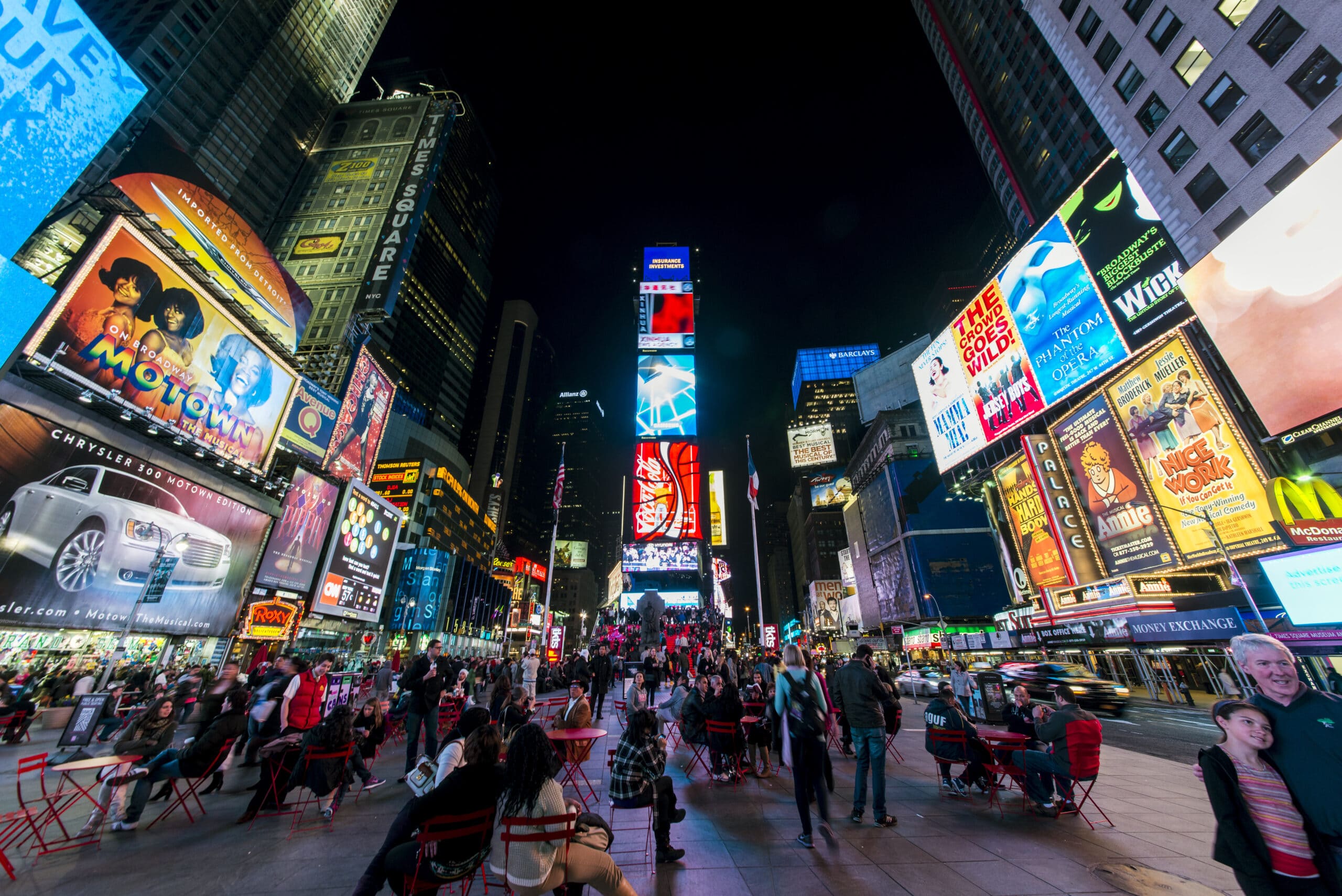The advertising industry is one of the most influential drivers in changing modern society, yet the environmental impact of advertising is often overlooked. The responsibility the sector holds in addressing climate change could be pivotal in creating more pro-environment attitudes.
—
The Superbowl LVII took place on February 12, 2023. With just over 113 million viewers, it accomplished an impressive ranking of third in the most watched Superbowls of all time. Some watch it for the sport, some watch it for the show, but some turn on their TVs purely for the ad campaigns that run in between. In fact, Superbowl commercial breaks are far more than breaks entirely; they are an integrated and important part of the almost four-hour experience.
While most of us dread to toll through the ad intervals of our favourite shows, Superbowl ad campaigns deliver an experience designed to drop jaws; similar to watching trailers at the cinema, but with a more dystopian feel.

An estimated 113.06 million viewers were tuned in for Super Bowl LVII in February 2023. Photo by Wikimedia Commons
While advertising sits uncomfortably between the realms of art and science, its influence on modern culture might be stronger than the two entirely. John Storey, at the University of Sunderland, UK, noted that a “consumer society could just as easily be called an advertising society”. Back in 2007, before online advertising really took off, market research firm Yankelovich estimated that Americans on average saw up to 5,000 advertisements a day. Backed by the aggressive form of capitalism that runs large parts of the world today, ad-influenced consumerism is through the roof. The business is currently valued at around US$600 billion and is increasing every year.
With climate change making itself more noticeable by the day, what responsibility does the advertising industry hold in creating a more sustainable future?
Traditional Advertising
Advertising has come a long way from its humble beginnings.
Before the 18th century, advertising occurred sporadically. The oldest known printed advert is a notice by William Caxton in England in 1477 ,presenting his edition of a religious rule book. “If it ple[a]se any man,” Caxton begins the advert earnestly and with an air of passivity towards its overall success. In April 1704, the USA saw the first continuously-published newspaper, the Boston Newsletter; the first medium of public dissemination which gave way to the birth of modern advertising. Just two weeks later, the first ad was published selling a plantation in Long Island. In 1786, William Taylor founded the first advertising agency in London, in what could be considered the start of the industry. Newspaper and print dominated for a large majority, however, the desire for commercial growth led to more invasive and creative methods of attracting attention. Billboards were invented in the 1830s by Jared Bell, looking to showcase his circus, and led to the popularisation of advertisements in outdoor spaces. The first advertisement for radio arrived in 1922 in the form of a ten-minute sales pitch by a New York real estate developer. For the first time, the advertising industry had been provided with a direct route into the homes of their target audience.
By the second half of the 20th century, economic growth was vitally needed for many nations after the financial turmoil of the Second World War. Governments implored their citizens to spend more money for the good of the country. So began a wave of consumerism previously unheard of. With this wave came the opportunity for the advertising industry to fully utilise its potential. What was once a tool driven by honest purpose from humble vendors publicising their products became a substantially lucrative business capable of large influence, and just in time for one of its largest platforms – television. The Golden Age of Advertising was dominated by print, radio, and television, with experts estimating that in the 1970s, consumers would be exposed to around 500 ads a day. And with a persuasive and tactical use of language far dissimilar to that of Caxton’s, wants were increasingly becoming needs.
Today, adverts are inescapable and are considered a necessity for the continuous growth and competition that businesses strive for. Despite being the international leader in beverages, a household name, and drawing a net revenue of $43 billion in 2022 (an 11% increase from the year before), Coca-Cola still spends around $4.5 billion a year on advertising. What comes at a heavy price for this commercial competition is the carbon footprint, which is higher than ever.
It comes as a slap in the face to use the term “carbon footprint” when understanding the role of advertising in its conception. While many industries are being scrutinised for their negative implications on the planet, the advertising industry has largely been overlooked. A lot of these emissions come from the production of the adverts, with businesses demanding high production value and choosing to shoot overseas. Electronic signage also plays a significant role in the industry’s carbon emissions. For instance, campaigners in the UK estimated that a double-sided digital bus stop advertising screen consumes four times more electricity than the average British home. To put this on a larger scale, the energy needed to power Times Square in New York has been estimated at 161 megawatts a day, enough to power around 160,000 homes.

Times Square in New York consumes about 161 megawatts a day, enough to power around 160,000 homes. Photo by Wikimedia Commons.
However, traditional advertising is just one side of the story when understanding the industry’s carbon emissions. At the turn of the century came the rise of the digital world which gave advertising more access, more opportunity, and more intrusion than ever before.
Online Advertising
With the rise of online advertising and whole new varieties of media content, a new cause of carbon emissions presented itself through web traffic and communications technology. During the 2010s, global ad spending saw online advertising take over from traditional with mobile leading the way. In some ways, the switch to digital advertising should have been a good thing.
Analysing advertising and climate change, Patrick Hartmann and colleagues note that the environmental impact of the industry “should have decreased” in the internet age. After all, online ads negated the need for the mass production of materials that print media depended on. However, the sheer increase in the production of online advertising has boosted the industry’s carbon footprint to the point of eliminating the environmental gains of its resource efficiency.
It can be difficult to comprehend that the digital world even has a carbon footprint. Other than the electricity to power your phone or laptop, scrolling through social media or sending an email seems like the most minutely significant activity. It is not like hearing the fumes cough out of your car exhaust or leaving the lights on overnight; the consequences of digital activity do not feel tied to the real world. However, the reality is that they are.
With the ever-increasing number of ads that you see on apps and websites, there is a need for more powerful and energy-consuming infrastructure to support the amount of traffic. A study done by Pärssinen and colleagues found that online advertising “consumes vast amounts of energy” and contributes around 10-20% of the total internet infrastructure’s consumption. Additionally, Ryan Cochrane, COO of Good-Loop has noted that with the rise of programmatic advertising, whereby website ad spaces are automatically bought and sold to the best-fitted advertisers, we now need to factor in the carbon emissions of “trillions of auctions that take place every day without any ads being served at all.”
With more and more companies demanding you provide an email address before you use their services, the inbox has become a hotbed for newsletters, special offers, company updates, and general spam that are distributed to mailing lists on an almost daily basis. On average, a single email will emit 4g of CO2-equivalent gases. This number is very insignificant until you realise how many emails are sent each day. The Radicati Group measured the total number of business and consumer emails sent and received, calculating that it will exceed 376 billion a day by 2025.
With more than 8 billion people on the planet and only 4.4 billion with access to emails, this number is shocking. All the more so when a high proportion of the emails you receive daily are the ones you delete and skim through with barely any thought. In 2019, Mailchimp, the email marketing service, analysed the open rate of emails sent to their clients, be it a one-person startup or a Fortune 500 company, in a range of different industries. For a company that sends out billions of emails a month, they concluded that around 21.33% were opened by the customer.
Like how advertising has implemented itself as a foundation of modern society, so too does it play a vital role in the core democracy of the internet. Advertising is the sole reason so many apps and websites are free to use, and a lot of users will be lost if businesses choose to charge. For instance, 2.6 billion people access YouTube each month, despite the platform only having around 80 million premium subscribers. Justifiably, most people are not willing to spend their hard-earned cash just to remove ads from one platform. The price, instead, is a huge amount of web traffic and energy consumption. Observe this excerpt from Pärssinen and colleagues in 2018:
“Netflix’s share of the total downstream traffic in America is 37.05%. Let’s assume this is their global share. If Netflix changed its business model to that of Spotify, which is free to use if the user accepts advertisements, the effect on the Internet energy consumption would be substantial. If an additional 10% is assumed as the advertising video traffic, based on our framework, on a global level [an] additional 42.02 TWh of energy would be consumed, and 23.76 million tons of CO2e emitted.”
You might also like: COP27 Sponsor Coca-Cola Increased Plastic Use Ahead of Summit
The Environmental Impact of Advertising
Are we humans, or are we consumers?
Since the 1950s, advertising has been the backbone of economic growth through its encouragement of materialism and consumerism, something which has only increased in the age of social media and influencers. Despite this being an indirect cause of carbon emissions, it could be considered an even larger contributor to environmentally damaging practices.
Hartmann and colleagues note that “individuals who prioritise materialistic values and goals do not only consume more but also act in less environmentally friendly ways.” The consumption of meat by an average American citizen, for example, has increased from 197 pounds in the 1960s to 275 pounds in 2008. Despite an uptick in sales for plant-based food products, global consumption of meat is expected to increase by 14% by the end of the decade. SheIn, the dark horse of fast fashion, generated $30 billion in 2022, a 91% increase from the year before. A widely popular movement called Earth Overshoot Day has calculated that we would need 5.1 Earth to accommodate the general consumption of a typical American.
Purpose Disruptors have defined the term “advertised emissions” as the CO2 emissions produced by the uptake of sales generated by advertising. Such carbon-intensive advertising includes fossil fuels, transport such as automotive and aviation, and red meat. According to their calculations, advertised emissions in the UK rose by 11% from 2019 to 2022, producing 208 million tonnes of CO2e emissions. This is the equivalent of adding an extra 28% to the carbon footprint of every UK citizen annually. While the industry would have to reduce emissions to 93 million tonnes by 2030 to be in line with the Paris Climate Agreement, the current trend would instead see the industry rise to 273 million tonnes. In this regard, co-founder Jonathon Wise said: “This report will provide the necessary stimulus to talk about the elephant in the room: advertising drives consumption and consumption drives carbon emissions.”
Some in the industry have questioned whether the undoubted responsibility advertising has in driving consumption is taking away from the bigger picture. As David Park, Associate Professor at Florida International University, puts it, “advertising is an indispensable tool of capitalism.”
“Much of production in capitalism has little to do with the satisfaction of genuine human needs and more to do with the profit motive that drives the extraction of raw materials to produce a never-ending supply of goods.”
Advertising is merely encouraging a system that is already rooted in the foundations of most modern societies. Economic growth has been a policy goal for many Western countries since the 1950s and the tumultuous period after the Second World War. In fact, consumerism is seen as an act of patriotism.
George W. Bush expressed it as a national necessity for citizens after a lack of growth following the 9/11 attacks. Perhaps more attention needs to be given to governments that promote unsustainable practices, or even the form of capitalism that feeds on continuous growth. Much like how tobacco advertising was banned for its damaging effects, governments need to do more to regulate adverts that promote carbon-intensive practices.
Conclusion
The advertising industry clearly has a large responsibility in tilting our world towards a more sustainable future, but people are becoming aware and are doing something about it.
Data from attention measurement and optimisation company Playground xyz suggests that 40% of digital ads are not viewed despite being present on the screen. Their study finds that removing advertising from domains where ‘Attention Time’ (the amount of time the audience views the advert) is below 0.5 seconds, on average, saw total emissions fall by 63%. In August last year, France rolled out legislation banning the advertising of energy products related to fossil fuels. A month later, from the influence of a letter involving 200 health professionals and organisations, the City of Sydney Council banned fossil fuel advertising on its properties and events.
It is important to note that while you may feel helpless in your contribution to ad-related carbon emissions, you should not deem it a burden. It is not at the fault of the individual that an ad pops up while scrolling social media or they receive a promotional email from a company they reluctantly signed up to. Even our consumerist behaviours are conditioned by tactical advertising strategies prevalent in a world that makes us believe more is better. But that does not mean you can’t change things. Write to local politicians, sign petitions, and promote green advertising on your own media channels or publications.
In a world desperate for more sustainable practices, the time has come for people to be seen as more than just consumers.
You might also like: 10 Companies Called Out For Greenwashing


















